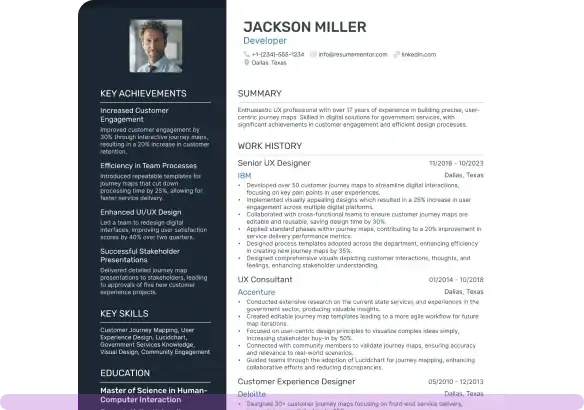Dermatologist Resume Examples

Jul 18, 2024
|
12 min read
Craft your standout dermatologist resume: Essential tips for a flawless application to skin the competition!
Rated by 348 people
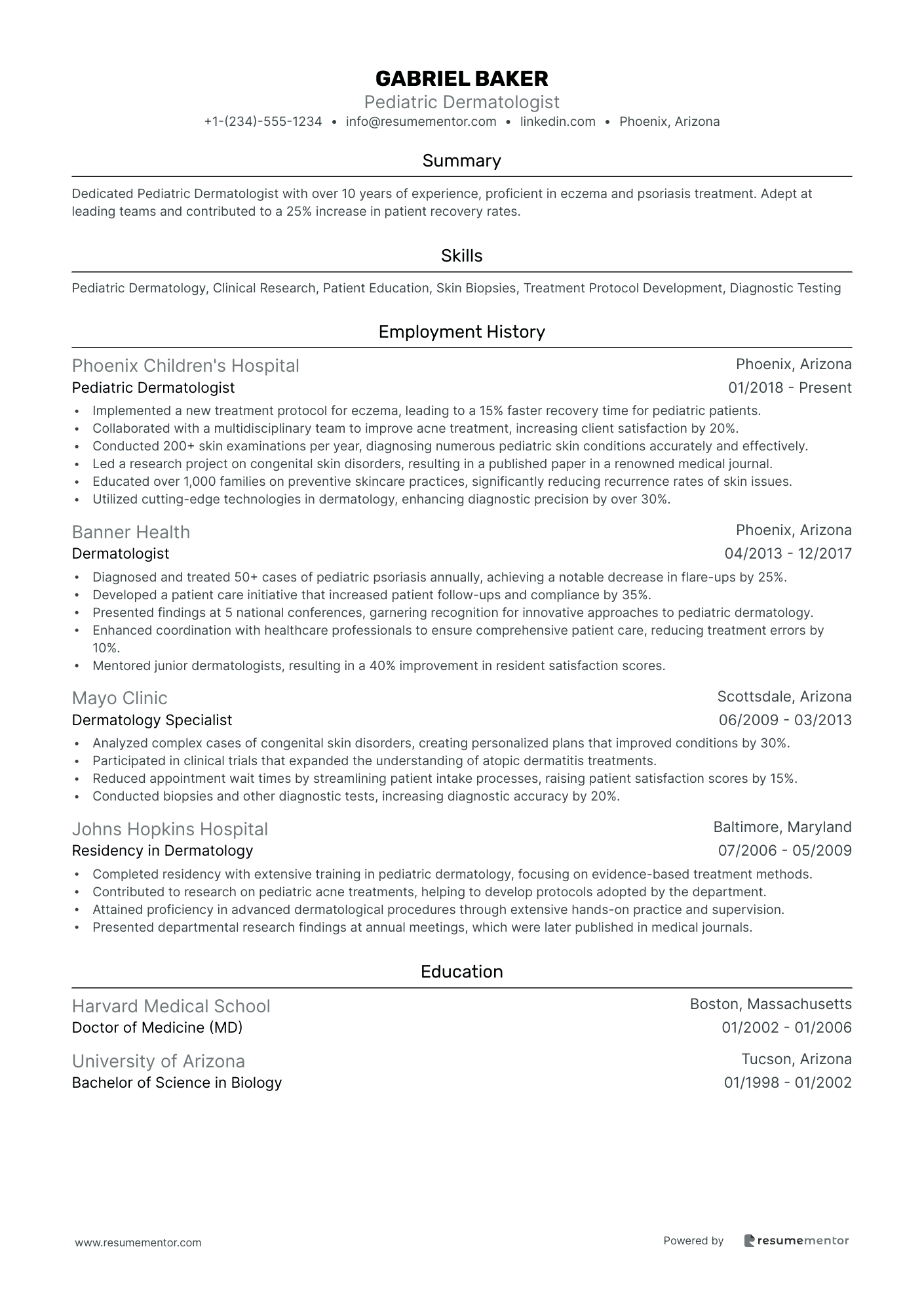
Pediatric Dermatologist
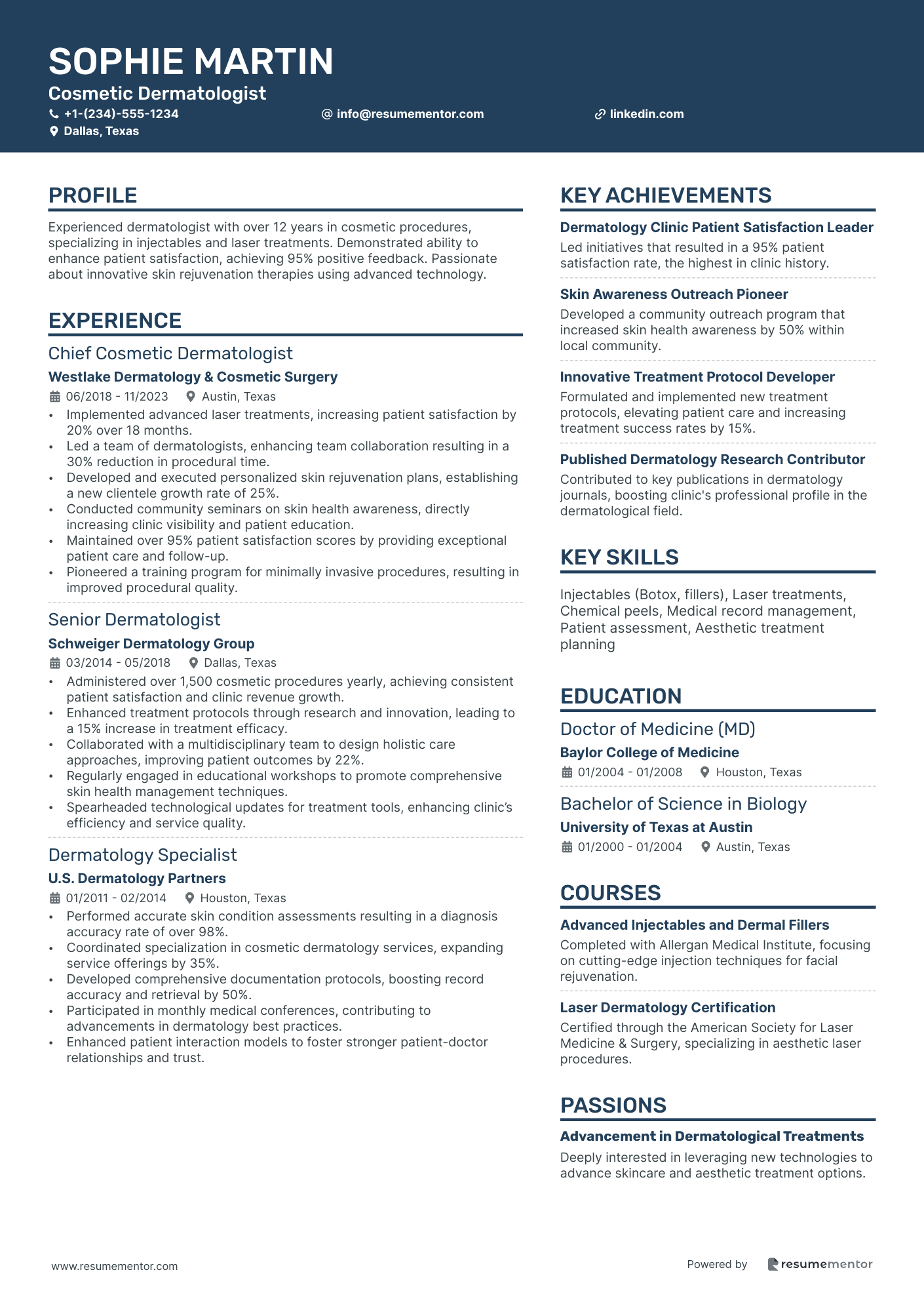
Cosmetic Dermatologist
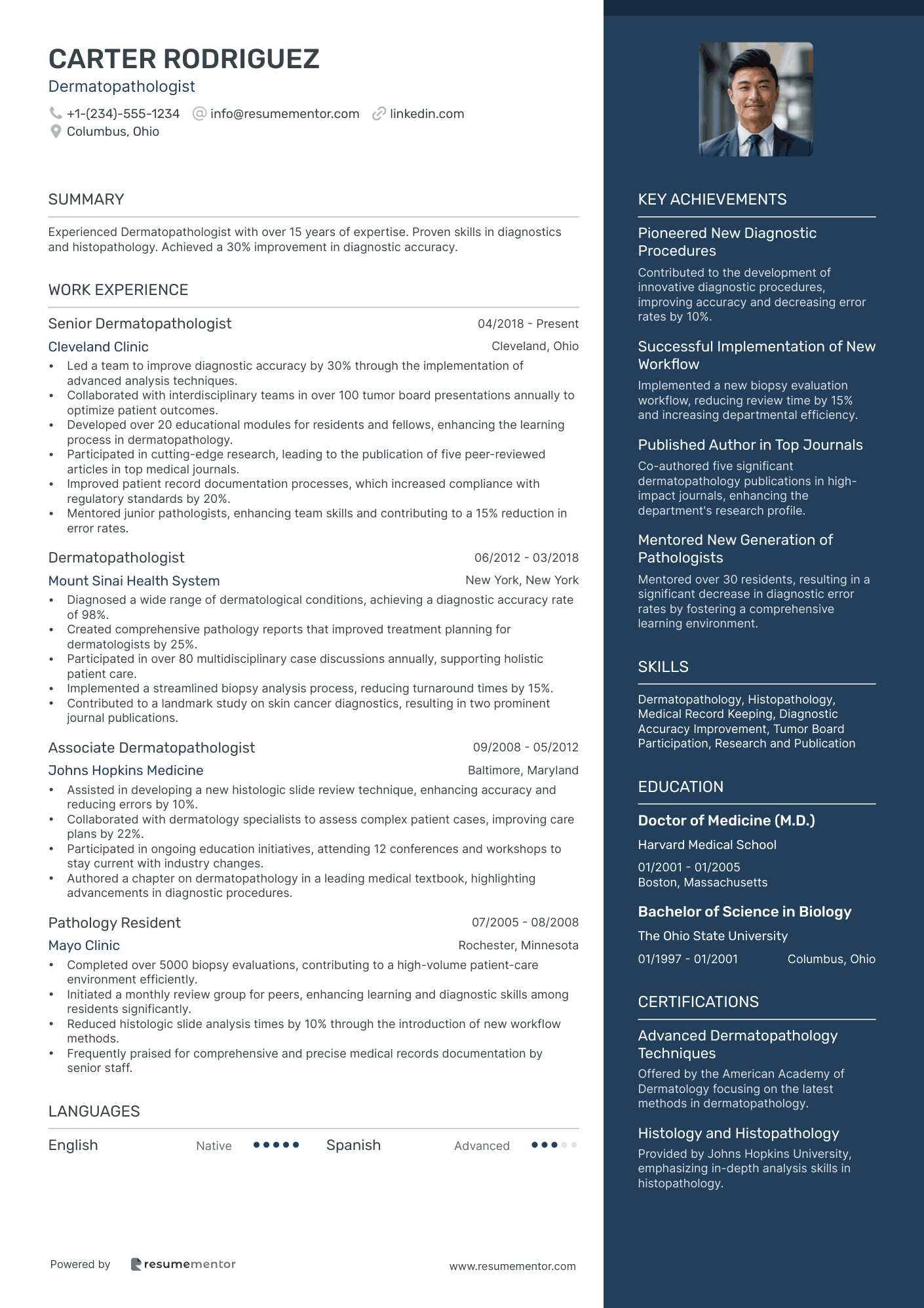
Dermatopathologist
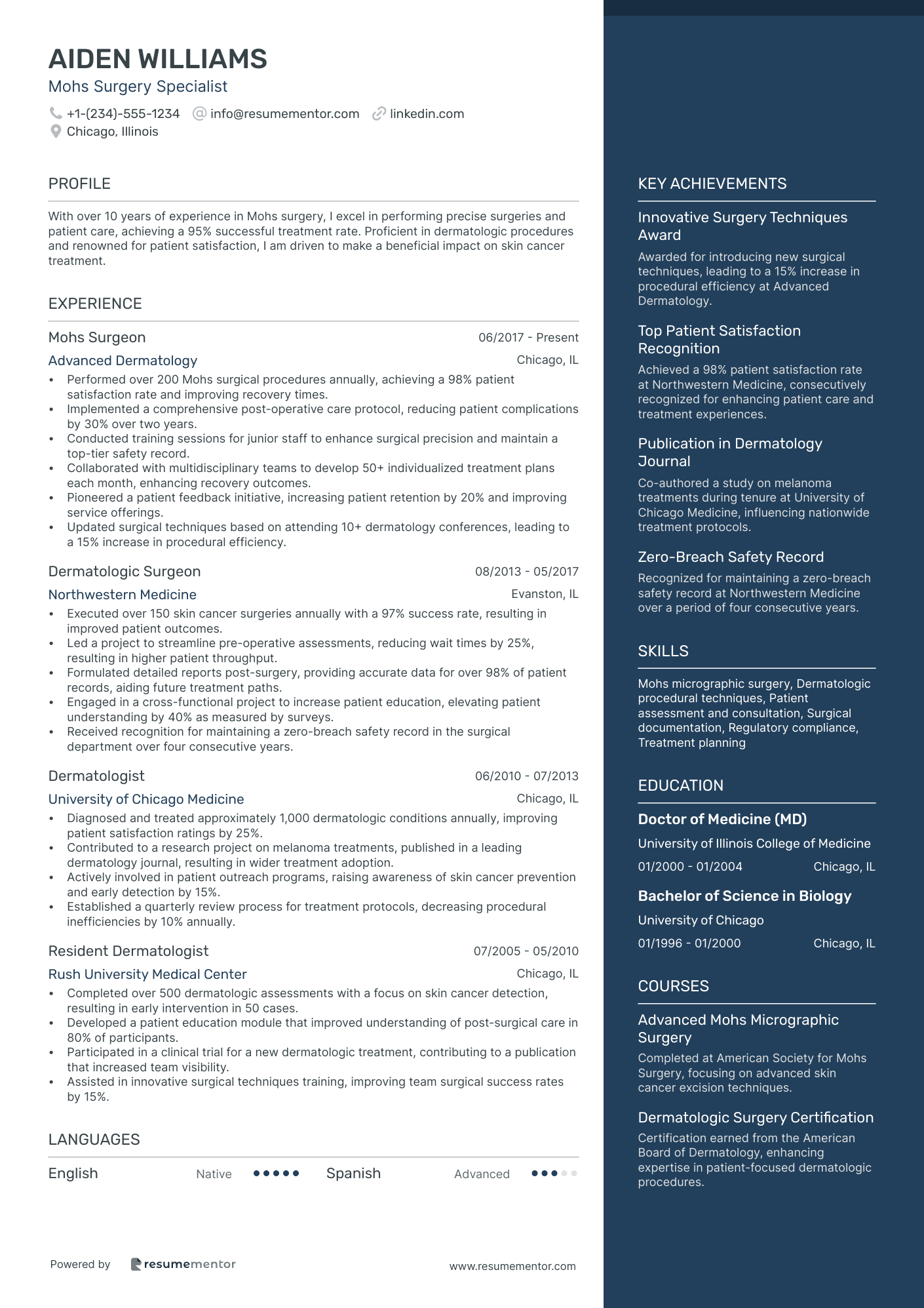
Mohs Surgery Specialist
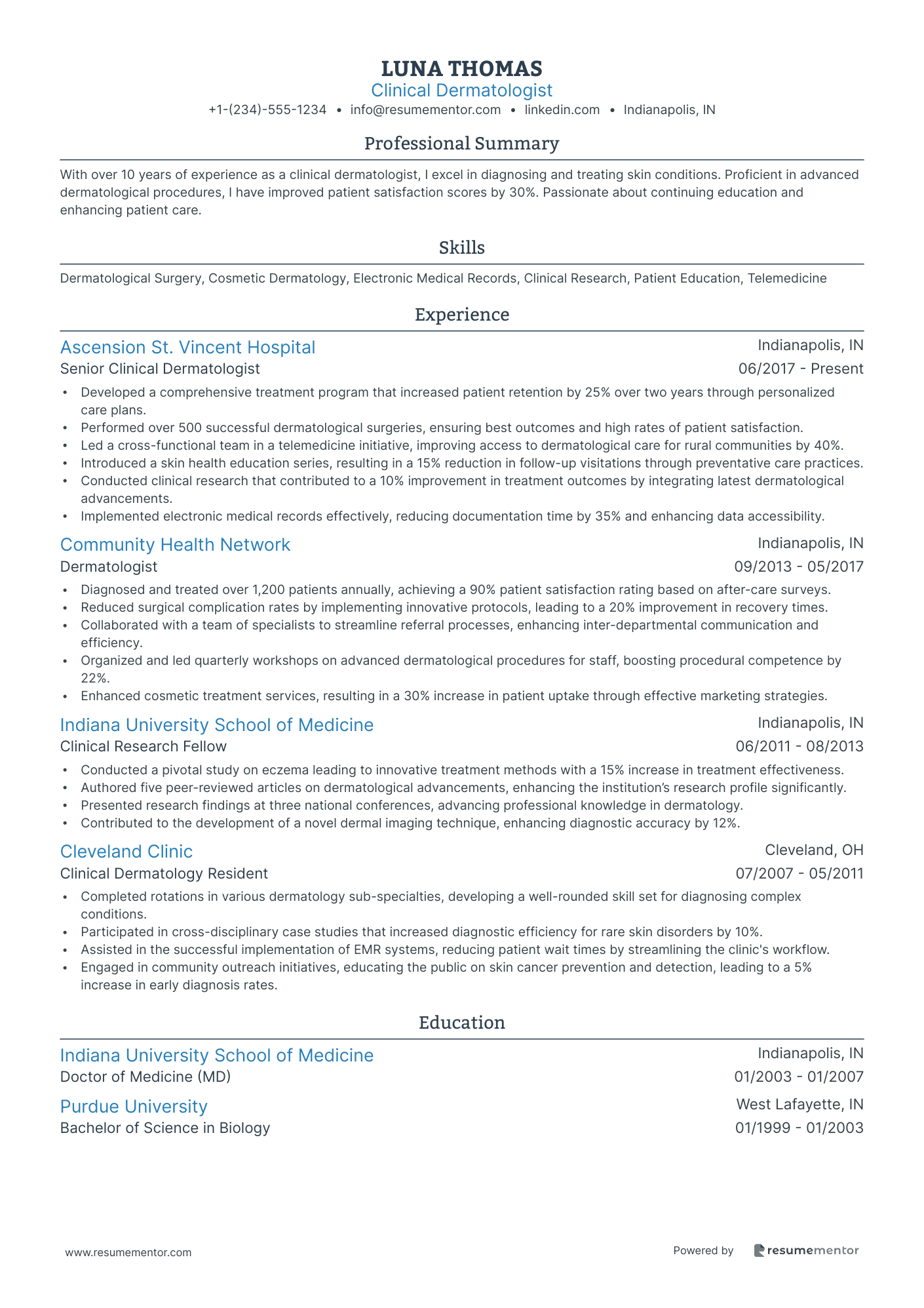
Clinical Dermatologist
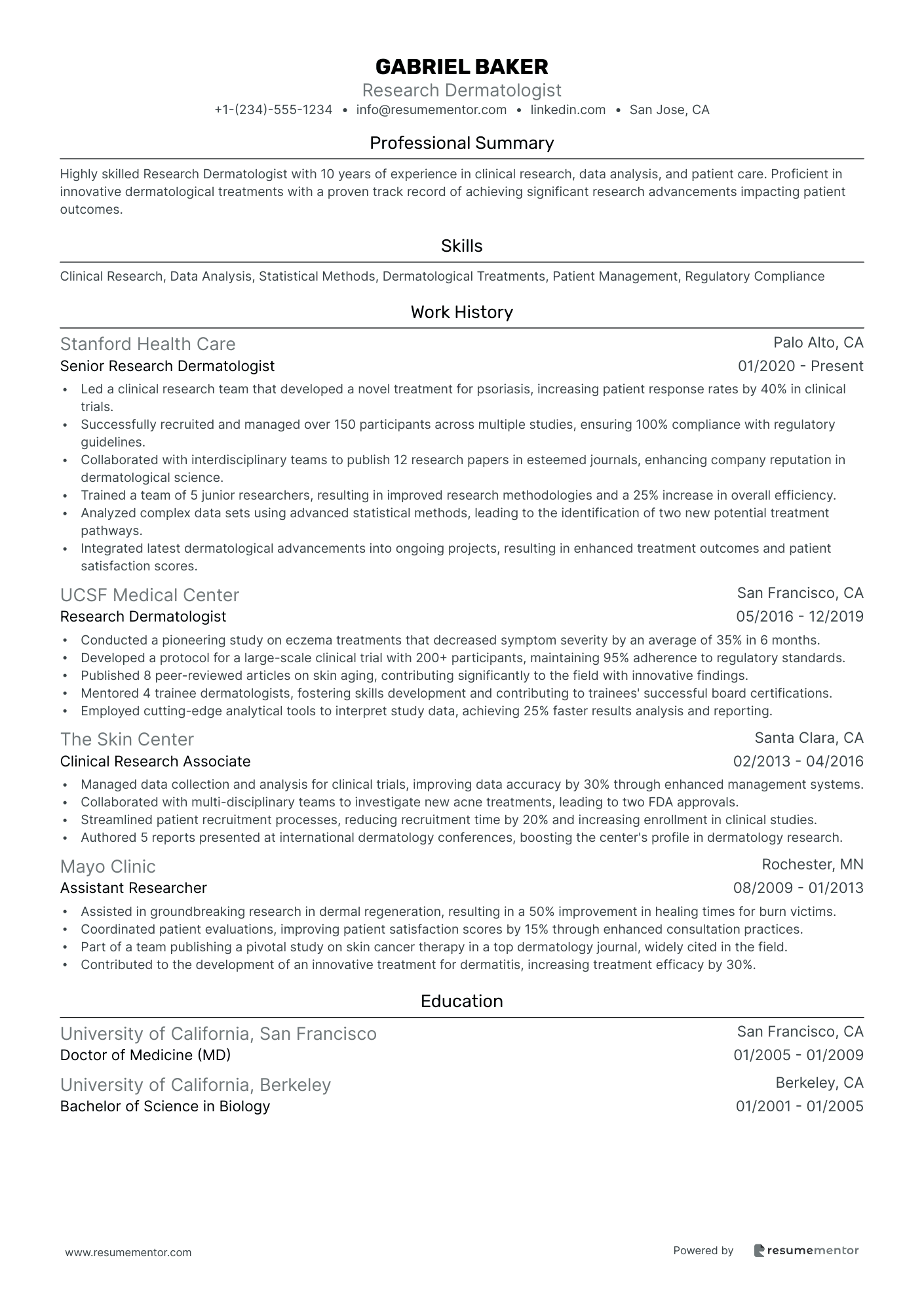
Research Dermatologist
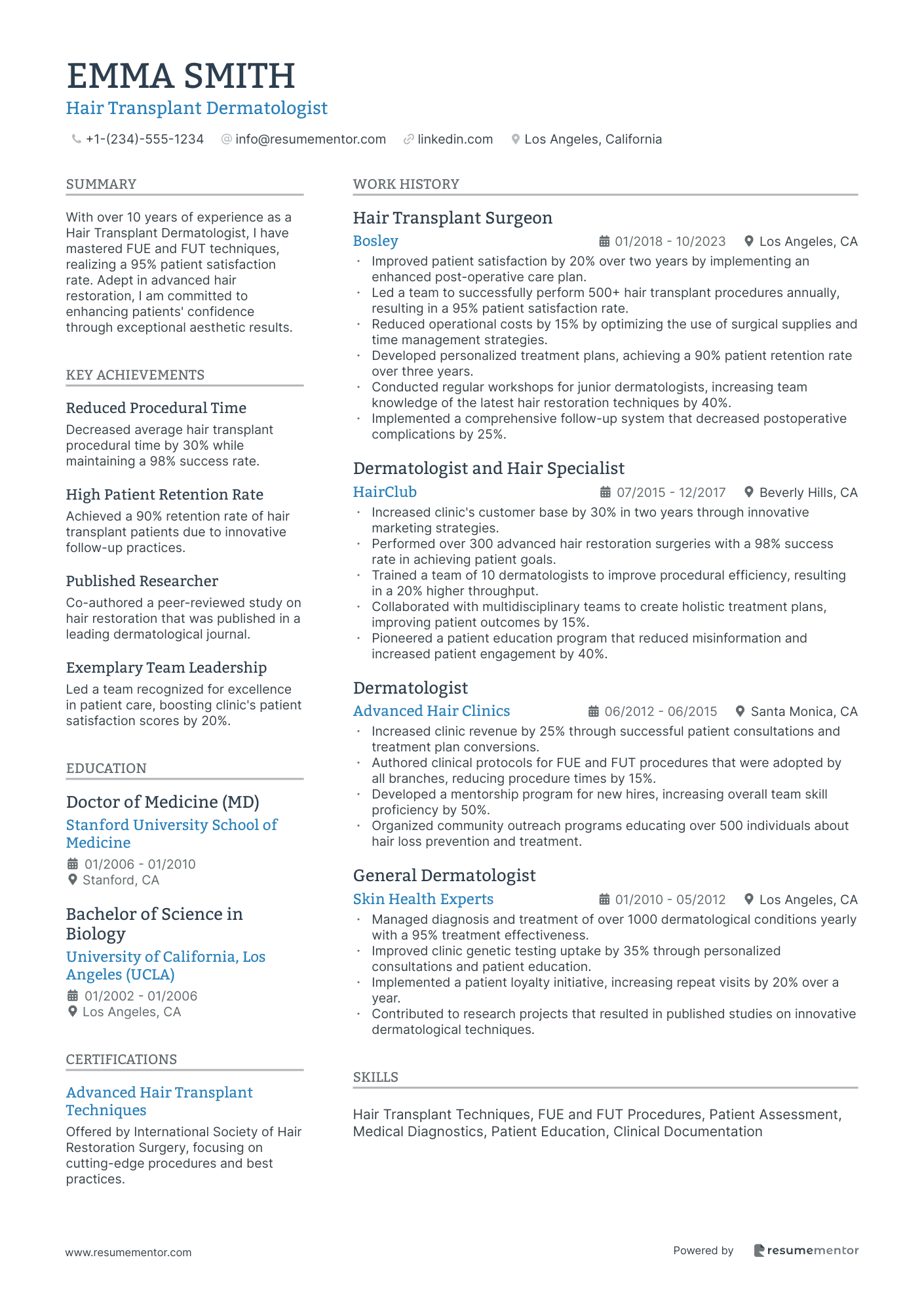
Hair Transplant Dermatologist
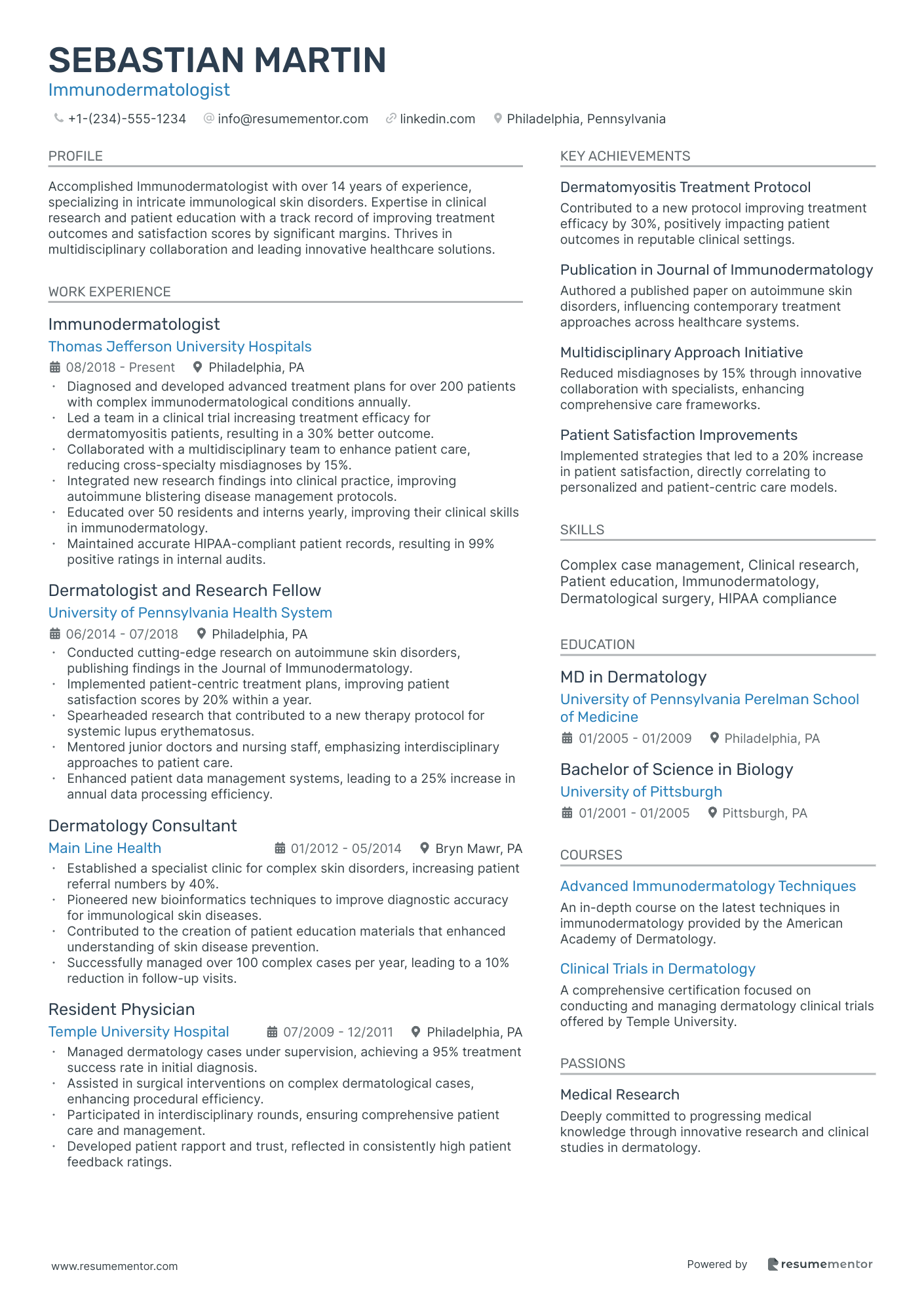
Immunodermatologist
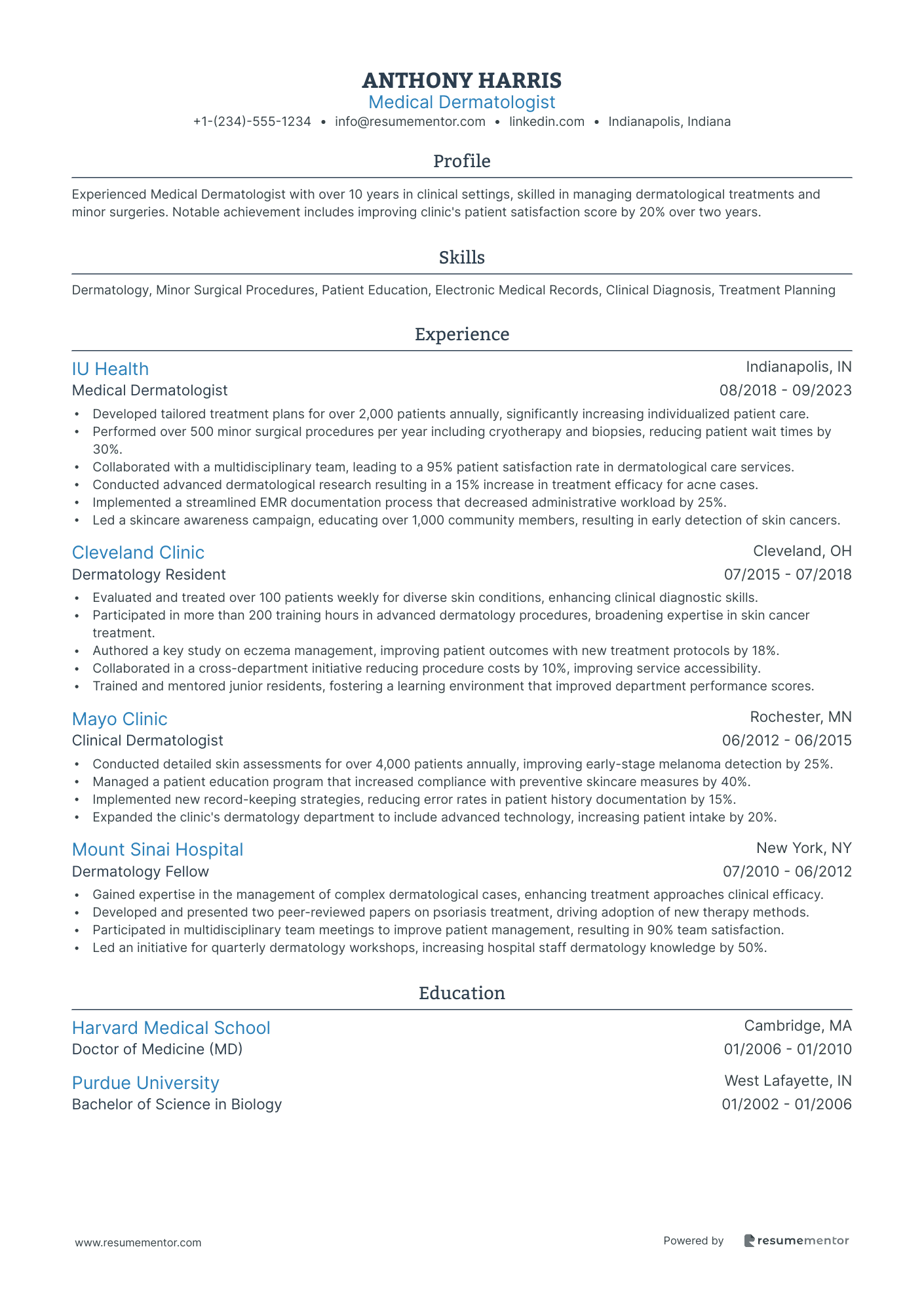
Medical Dermatologist

Dermato-oncologist
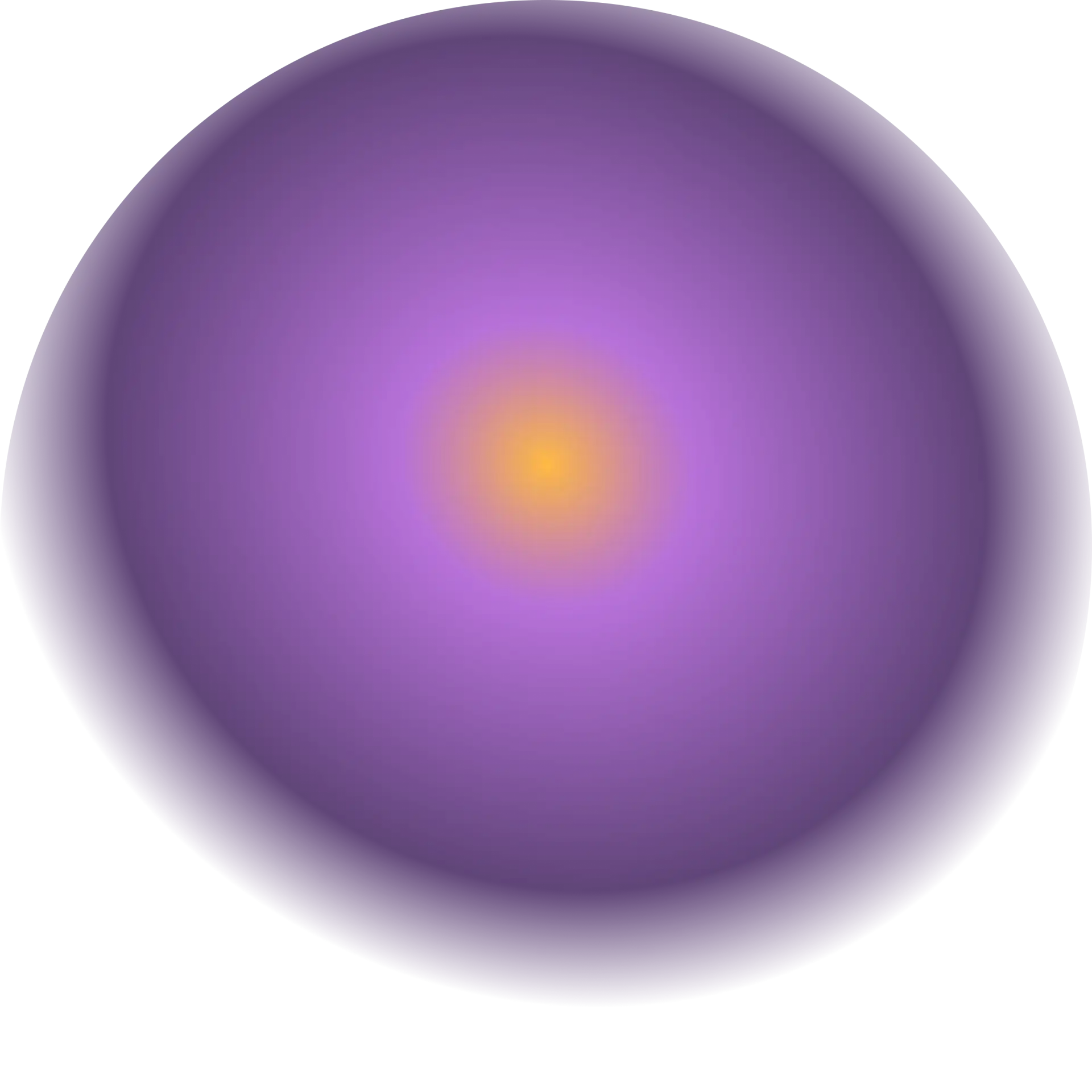
Pediatric Dermatologist resume sample
- •Implemented a new treatment protocol for eczema, leading to a 15% faster recovery time for pediatric patients.
- •Collaborated with a multidisciplinary team to improve acne treatment, increasing client satisfaction by 20%.
- •Conducted 200+ skin examinations per year, diagnosing numerous pediatric skin conditions accurately and effectively.
- •Led a research project on congenital skin disorders, resulting in a published paper in a renowned medical journal.
- •Educated over 1,000 families on preventive skincare practices, significantly reducing recurrence rates of skin issues.
- •Utilized cutting-edge technologies in dermatology, enhancing diagnostic precision by over 30%.
- •Diagnosed and treated 50+ cases of pediatric psoriasis annually, achieving a notable decrease in flare-ups by 25%.
- •Developed a patient care initiative that increased patient follow-ups and compliance by 35%.
- •Presented findings at 5 national conferences, garnering recognition for innovative approaches to pediatric dermatology.
- •Enhanced coordination with healthcare professionals to ensure comprehensive patient care, reducing treatment errors by 10%.
- •Mentored junior dermatologists, resulting in a 40% improvement in resident satisfaction scores.
- •Analyzed complex cases of congenital skin disorders, creating personalized plans that improved conditions by 30%.
- •Participated in clinical trials that expanded the understanding of atopic dermatitis treatments.
- •Reduced appointment wait times by streamlining patient intake processes, raising patient satisfaction scores by 15%.
- •Conducted biopsies and other diagnostic tests, increasing diagnostic accuracy by 20%.
- •Completed residency with extensive training in pediatric dermatology, focusing on evidence-based treatment methods.
- •Contributed to research on pediatric acne treatments, helping to develop protocols adopted by the department.
- •Attained proficiency in advanced dermatological procedures through extensive hands-on practice and supervision.
- •Presented departmental research findings at annual meetings, which were later published in medical journals.
Cosmetic Dermatologist resume sample
- •Implemented advanced laser treatments, increasing patient satisfaction by 20% over 18 months.
- •Led a team of dermatologists, enhancing team collaboration resulting in a 30% reduction in procedural time.
- •Developed and executed personalized skin rejuvenation plans, establishing a new clientele growth rate of 25%.
- •Conducted community seminars on skin health awareness, directly increasing clinic visibility and patient education.
- •Maintained over 95% patient satisfaction scores by providing exceptional patient care and follow-up.
- •Pioneered a training program for minimally invasive procedures, resulting in improved procedural quality.
- •Administered over 1,500 cosmetic procedures yearly, achieving consistent patient satisfaction and clinic revenue growth.
- •Enhanced treatment protocols through research and innovation, leading to a 15% increase in treatment efficacy.
- •Collaborated with a multidisciplinary team to design holistic care approaches, improving patient outcomes by 22%.
- •Regularly engaged in educational workshops to promote comprehensive skin health management techniques.
- •Spearheaded technological updates for treatment tools, enhancing clinic’s efficiency and service quality.
- •Performed accurate skin condition assessments resulting in a diagnosis accuracy rate of over 98%.
- •Coordinated specialization in cosmetic dermatology services, expanding service offerings by 35%.
- •Developed comprehensive documentation protocols, boosting record accuracy and retrieval by 50%.
- •Participated in monthly medical conferences, contributing to advancements in dermatology best practices.
- •Enhanced patient interaction models to foster stronger patient-doctor relationships and trust.
- •Administered daily cosmetic dermatology procedures with an emphasis on patient-focused outcomes.
- •Contributed to research projects leading to publication in dermatology journals, elevating clinic's prestige.
- •Refined chemical peel techniques to enhance treatment effectiveness, leading to improved patient results.
- •Ensured consistent knowledge update through participation in specialized cosmetic dermatology courses.
Dermatopathologist resume sample
- •Led a team to improve diagnostic accuracy by 30% through the implementation of advanced analysis techniques.
- •Collaborated with interdisciplinary teams in over 100 tumor board presentations annually to optimize patient outcomes.
- •Developed over 20 educational modules for residents and fellows, enhancing the learning process in dermatopathology.
- •Participated in cutting-edge research, leading to the publication of five peer-reviewed articles in top medical journals.
- •Improved patient record documentation processes, which increased compliance with regulatory standards by 20%.
- •Mentored junior pathologists, enhancing team skills and contributing to a 15% reduction in error rates.
- •Diagnosed a wide range of dermatological conditions, achieving a diagnostic accuracy rate of 98%.
- •Created comprehensive pathology reports that improved treatment planning for dermatologists by 25%.
- •Participated in over 80 multidisciplinary case discussions annually, supporting holistic patient care.
- •Implemented a streamlined biopsy analysis process, reducing turnaround times by 15%.
- •Contributed to a landmark study on skin cancer diagnostics, resulting in two prominent journal publications.
- •Assisted in developing a new histologic slide review technique, enhancing accuracy and reducing errors by 10%.
- •Collaborated with dermatology specialists to assess complex patient cases, improving care plans by 22%.
- •Participated in ongoing education initiatives, attending 12 conferences and workshops to stay current with industry changes.
- •Authored a chapter on dermatopathology in a leading medical textbook, highlighting advancements in diagnostic procedures.
- •Completed over 5000 biopsy evaluations, contributing to a high-volume patient-care environment efficiently.
- •Initiated a monthly review group for peers, enhancing learning and diagnostic skills among residents significantly.
- •Reduced histologic slide analysis times by 10% through the introduction of new workflow methods.
- •Frequently praised for comprehensive and precise medical records documentation by senior staff.
Mohs Surgery Specialist resume sample
- •Performed over 200 Mohs surgical procedures annually, achieving a 98% patient satisfaction rate and improving recovery times.
- •Implemented a comprehensive post-operative care protocol, reducing patient complications by 30% over two years.
- •Conducted training sessions for junior staff to enhance surgical precision and maintain a top-tier safety record.
- •Collaborated with multidisciplinary teams to develop 50+ individualized treatment plans each month, enhancing recovery outcomes.
- •Pioneered a patient feedback initiative, increasing patient retention by 20% and improving service offerings.
- •Updated surgical techniques based on attending 10+ dermatology conferences, leading to a 15% increase in procedural efficiency.
- •Executed over 150 skin cancer surgeries annually with a 97% success rate, resulting in improved patient outcomes.
- •Led a project to streamline pre-operative assessments, reducing wait times by 25%, resulting in higher patient throughput.
- •Formulated detailed reports post-surgery, providing accurate data for over 98% of patient records, aiding future treatment paths.
- •Engaged in a cross-functional project to increase patient education, elevating patient understanding by 40% as measured by surveys.
- •Received recognition for maintaining a zero-breach safety record in the surgical department over four consecutive years.
- •Diagnosed and treated approximately 1,000 dermatologic conditions annually, improving patient satisfaction ratings by 25%.
- •Contributed to a research project on melanoma treatments, published in a leading dermatology journal, resulting in wider treatment adoption.
- •Actively involved in patient outreach programs, raising awareness of skin cancer prevention and early detection by 15%.
- •Established a quarterly review process for treatment protocols, decreasing procedural inefficiencies by 10% annually.
- •Completed over 500 dermatologic assessments with a focus on skin cancer detection, resulting in early intervention in 50 cases.
- •Developed a patient education module that improved understanding of post-surgical care in 80% of participants.
- •Participated in a clinical trial for a new dermatologic treatment, contributing to a publication that increased team visibility.
- •Assisted in innovative surgical techniques training, improving team surgical success rates by 15%.
Clinical Dermatologist resume sample
- •Developed a comprehensive treatment program that increased patient retention by 25% over two years through personalized care plans.
- •Performed over 500 successful dermatological surgeries, ensuring best outcomes and high rates of patient satisfaction.
- •Led a cross-functional team in a telemedicine initiative, improving access to dermatological care for rural communities by 40%.
- •Introduced a skin health education series, resulting in a 15% reduction in follow-up visitations through preventative care practices.
- •Conducted clinical research that contributed to a 10% improvement in treatment outcomes by integrating latest dermatological advancements.
- •Implemented electronic medical records effectively, reducing documentation time by 35% and enhancing data accessibility.
- •Diagnosed and treated over 1,200 patients annually, achieving a 90% patient satisfaction rating based on after-care surveys.
- •Reduced surgical complication rates by implementing innovative protocols, leading to a 20% improvement in recovery times.
- •Collaborated with a team of specialists to streamline referral processes, enhancing inter-departmental communication and efficiency.
- •Organized and led quarterly workshops on advanced dermatological procedures for staff, boosting procedural competence by 22%.
- •Enhanced cosmetic treatment services, resulting in a 30% increase in patient uptake through effective marketing strategies.
- •Conducted a pivotal study on eczema leading to innovative treatment methods with a 15% increase in treatment effectiveness.
- •Authored five peer-reviewed articles on dermatological advancements, enhancing the institution’s research profile significantly.
- •Presented research findings at three national conferences, advancing professional knowledge in dermatology.
- •Contributed to the development of a novel dermal imaging technique, enhancing diagnostic accuracy by 12%.
- •Completed rotations in various dermatology sub-specialties, developing a well-rounded skill set for diagnosing complex conditions.
- •Participated in cross-disciplinary case studies that increased diagnostic efficiency for rare skin disorders by 10%.
- •Assisted in the successful implementation of EMR systems, reducing patient wait times by streamlining the clinic's workflow.
- •Engaged in community outreach initiatives, educating the public on skin cancer prevention and detection, leading to a 5% increase in early diagnosis rates.
Research Dermatologist resume sample
- •Led a clinical research team that developed a novel treatment for psoriasis, increasing patient response rates by 40% in clinical trials.
- •Successfully recruited and managed over 150 participants across multiple studies, ensuring 100% compliance with regulatory guidelines.
- •Collaborated with interdisciplinary teams to publish 12 research papers in esteemed journals, enhancing company reputation in dermatological science.
- •Trained a team of 5 junior researchers, resulting in improved research methodologies and a 25% increase in overall efficiency.
- •Analyzed complex data sets using advanced statistical methods, leading to the identification of two new potential treatment pathways.
- •Integrated latest dermatological advancements into ongoing projects, resulting in enhanced treatment outcomes and patient satisfaction scores.
- •Conducted a pioneering study on eczema treatments that decreased symptom severity by an average of 35% in 6 months.
- •Developed a protocol for a large-scale clinical trial with 200+ participants, maintaining 95% adherence to regulatory standards.
- •Published 8 peer-reviewed articles on skin aging, contributing significantly to the field with innovative findings.
- •Mentored 4 trainee dermatologists, fostering skills development and contributing to trainees' successful board certifications.
- •Employed cutting-edge analytical tools to interpret study data, achieving 25% faster results analysis and reporting.
- •Managed data collection and analysis for clinical trials, improving data accuracy by 30% through enhanced management systems.
- •Collaborated with multi-disciplinary teams to investigate new acne treatments, leading to two FDA approvals.
- •Streamlined patient recruitment processes, reducing recruitment time by 20% and increasing enrollment in clinical studies.
- •Authored 5 reports presented at international dermatology conferences, boosting the center's profile in dermatology research.
- •Assisted in groundbreaking research in dermal regeneration, resulting in a 50% improvement in healing times for burn victims.
- •Coordinated patient evaluations, improving patient satisfaction scores by 15% through enhanced consultation practices.
- •Part of a team publishing a pivotal study on skin cancer therapy in a top dermatology journal, widely cited in the field.
- •Contributed to the development of an innovative treatment for dermatitis, increasing treatment efficacy by 30%.
Hair Transplant Dermatologist resume sample
- •Improved patient satisfaction by 20% over two years by implementing an enhanced post-operative care plan.
- •Led a team to successfully perform 500+ hair transplant procedures annually, resulting in a 95% patient satisfaction rate.
- •Reduced operational costs by 15% by optimizing the use of surgical supplies and time management strategies.
- •Developed personalized treatment plans, achieving a 90% patient retention rate over three years.
- •Conducted regular workshops for junior dermatologists, increasing team knowledge of the latest hair restoration techniques by 40%.
- •Implemented a comprehensive follow-up system that decreased postoperative complications by 25%.
- •Increased clinic's customer base by 30% in two years through innovative marketing strategies.
- •Performed over 300 advanced hair restoration surgeries with a 98% success rate in achieving patient goals.
- •Trained a team of 10 dermatologists to improve procedural efficiency, resulting in a 20% higher throughput.
- •Collaborated with multidisciplinary teams to create holistic treatment plans, improving patient outcomes by 15%.
- •Pioneered a patient education program that reduced misinformation and increased patient engagement by 40%.
- •Increased clinic revenue by 25% through successful patient consultations and treatment plan conversions.
- •Authored clinical protocols for FUE and FUT procedures that were adopted by all branches, reducing procedure times by 15%.
- •Developed a mentorship program for new hires, increasing overall team skill proficiency by 50%.
- •Organized community outreach programs educating over 500 individuals about hair loss prevention and treatment.
- •Managed diagnosis and treatment of over 1000 dermatological conditions yearly with a 95% treatment effectiveness.
- •Improved clinic genetic testing uptake by 35% through personalized consultations and patient education.
- •Implemented a patient loyalty initiative, increasing repeat visits by 20% over a year.
- •Contributed to research projects that resulted in published studies on innovative dermatological techniques.
Immunodermatologist resume sample
- •Diagnosed and developed advanced treatment plans for over 200 patients with complex immunodermatological conditions annually.
- •Led a team in a clinical trial increasing treatment efficacy for dermatomyositis patients, resulting in a 30% better outcome.
- •Collaborated with a multidisciplinary team to enhance patient care, reducing cross-specialty misdiagnoses by 15%.
- •Integrated new research findings into clinical practice, improving autoimmune blistering disease management protocols.
- •Educated over 50 residents and interns yearly, improving their clinical skills in immunodermatology.
- •Maintained accurate HIPAA-compliant patient records, resulting in 99% positive ratings in internal audits.
- •Conducted cutting-edge research on autoimmune skin disorders, publishing findings in the Journal of Immunodermatology.
- •Implemented patient-centric treatment plans, improving patient satisfaction scores by 20% within a year.
- •Spearheaded research that contributed to a new therapy protocol for systemic lupus erythematosus.
- •Mentored junior doctors and nursing staff, emphasizing interdisciplinary approaches to patient care.
- •Enhanced patient data management systems, leading to a 25% increase in annual data processing efficiency.
- •Established a specialist clinic for complex skin disorders, increasing patient referral numbers by 40%.
- •Pioneered new bioinformatics techniques to improve diagnostic accuracy for immunological skin diseases.
- •Contributed to the creation of patient education materials that enhanced understanding of skin disease prevention.
- •Successfully managed over 100 complex cases per year, leading to a 10% reduction in follow-up visits.
- •Managed dermatology cases under supervision, achieving a 95% treatment success rate in initial diagnosis.
- •Assisted in surgical interventions on complex dermatological cases, enhancing procedural efficiency.
- •Participated in interdisciplinary rounds, ensuring comprehensive patient care and management.
- •Developed patient rapport and trust, reflected in consistently high patient feedback ratings.
Medical Dermatologist resume sample
- •Developed tailored treatment plans for over 2,000 patients annually, significantly increasing individualized patient care.
- •Performed over 500 minor surgical procedures per year including cryotherapy and biopsies, reducing patient wait times by 30%.
- •Collaborated with a multidisciplinary team, leading to a 95% patient satisfaction rate in dermatological care services.
- •Conducted advanced dermatological research resulting in a 15% increase in treatment efficacy for acne cases.
- •Implemented a streamlined EMR documentation process that decreased administrative workload by 25%.
- •Led a skincare awareness campaign, educating over 1,000 community members, resulting in early detection of skin cancers.
- •Evaluated and treated over 100 patients weekly for diverse skin conditions, enhancing clinical diagnostic skills.
- •Participated in more than 200 training hours in advanced dermatology procedures, broadening expertise in skin cancer treatment.
- •Authored a key study on eczema management, improving patient outcomes with new treatment protocols by 18%.
- •Collaborated in a cross-department initiative reducing procedure costs by 10%, improving service accessibility.
- •Trained and mentored junior residents, fostering a learning environment that improved department performance scores.
- •Conducted detailed skin assessments for over 4,000 patients annually, improving early-stage melanoma detection by 25%.
- •Managed a patient education program that increased compliance with preventive skincare measures by 40%.
- •Implemented new record-keeping strategies, reducing error rates in patient history documentation by 15%.
- •Expanded the clinic's dermatology department to include advanced technology, increasing patient intake by 20%.
- •Gained expertise in the management of complex dermatological cases, enhancing treatment approaches clinical efficacy.
- •Developed and presented two peer-reviewed papers on psoriasis treatment, driving adoption of new therapy methods.
- •Participated in multidisciplinary team meetings to improve patient management, resulting in 90% team satisfaction.
- •Led an initiative for quarterly dermatology workshops, increasing hospital staff dermatology knowledge by 50%.
Dermato-oncologist resume sample
- •Developed and managed over 300 individualized treatment plans annually for patients with melanoma and non-melanoma skin cancers.
- •Collaborated with a team of 15 oncologists to innovate strategies aimed at enhancing patient outcomes, resulting in a 15% increase in recovery rates.
- •Conducted clinical trials for new melanoma therapies, directly leading to the advancement of at least two novel treatments.
- •Performed over 250 Mohs micrographic surgeries annually, reducing patient recurrence rates significantly by up to 20%.
- •Published 10 research articles in peer-reviewed journals enhancing the institute's reputation in dermatologic oncology research.
- •Was instrumental in developing educational resources, drastically improving patient understanding by approximately 25%.
- •Executed over 150 advanced skin cancer surgeries annually, achieving a 10% increase in post-surgical recovery rates.
- •Led a program that educated over 1,000 patients and families on skin cancer prevention techniques, improving outreach efficacy significantly.
- •Authored 5 significant publications in top dermatologic journals, enhancing the center's knowledge base and visibility.
- •Collaborated with surgeons and dermatologists on 10 cross-disciplinary projects, achieving a 95% project completion success rate.
- •Implemented innovative skin cancer screening techniques that increased early detection rates by 15% over two years.
- •Diagnosed and treated over 200 patients with both common and rare skin conditions, resulting in enhanced patient care satisfaction.
- •Participated in the development of a state-wide educational campaign which increased public awareness by 30%.
- •Collaborated on interdisciplinary research that resulted in two improvements in treatment protocols adopted nationwide.
- •Achieved high patient approval ratings of over 90% by focusing on individualized care and comprehensive follow-up strategies.
- •Completed residency program with outstanding performance evaluations across all rotations, particularly in dermatologic oncology.
- •Supported senior physicians in over 1,200 patient consultations, contributing to high-standard patient care delivery.
- •Led a volunteer outreach project improving dermatologic care accessibility, positively impacting over 500 underprivileged individuals.
- •Contributed to 3 research projects focusing on skin cancer prevention and treatment protocols adopted internally.
Crafting a dermatologist's resume is like piecing together a complex diagnosis, where every detail counts. Your expertise in skin health is broad, but translating that onto paper can be tricky. Structuring your accomplishments, specialized skills, and training clearly is essential to reflect your true capabilities. This process is crucial in not just communicating your medical expertise, but also showing the impact you've made in your roles.
Since your resume offers employers a first look into your professional life, it deserves careful attention. More than just a list of jobs, it’s your chance to emphasize the precision and dedication inherent in your work. Using a resume template can guide you in organizing your thoughts, ensuring that you capture all vital information. For that, explore resume templates that provide a solid structure for your qualifications.
Employers seek clear evidence of your achievements and a deep understanding of dermatology. By interconnecting your experiences, you can tell a cohesive story of growth and successes in patient care. Just as diagnosing a complex skin condition requires insight, crafting a strong resume needs careful analysis. Let this guide support you in creating a resume that effectively showcases the depth and breadth of your skills.
Key Takeaways
- Crafting a dermatologist's resume involves clearly structuring accomplishments, skills, and training to reflect true expertise and impact in skin health roles.
- Using a resume template can aid in organizing thoughts and capturing all vital information, making your skills and achievements clear to potential employers.
- Employers seek evidence of both dermatological expertise and significant achievements, making it important to present a cohesive story of your growth in the field.
- Formatting is crucial; a chronological layout is recommended for medical fields, with modern fonts and PDF file-saving to preserve appearance across devices.
- Incorporating quantifiable achievements and effectively showcasing both technical and soft skills are key strategies to distinguish a dermatologist's resume.
What to focus on when writing your dermatologist resume
A dermatologist resume should clearly communicate your expertise in skin care and demonstrate your effectiveness in treating various dermatological conditions. Your experience, skills, and accomplishments should make you a standout candidate in this specialized field.
How to structure your dermatologist resume
- Contact Information: Begin with your name, phone number, email address, and location to ensure recruiters can easily reach you. Accuracy here is crucial, as it forms the initial point of connection between you and potential employers. Double-check for any typos, especially in your contact details, to avoid any communication issues with recruiters. Once your contact information is correct, move on to expressing your professional summary.
- Professional Summary: Follow with a concise overview of your dermatology experience, focusing on essential skills and specializations. This section is your chance to immediately capture the recruiter's interest by summarizing your qualifications and unique value. Mentioning key accomplishments, like successful treatments or innovative practices, can create a strong first impression. With a solid professional summary, you can guide the reader to your medical licenses and certifications.
- Medical Licenses and Certifications: Next, include details about your state medical license and board certifications, such as those from the American Board of Dermatology, to confirm your qualifications to practice. Specifying relevant certifications is vital, as they substantiate your legal and medical authority to operate as a dermatologist. Demonstrating that you meet professional standards reassures recruiters of your credentials. With your qualifications established, delve into your educational background.
- Education: Provide your educational background, listing your medical degree, dermatology residency, and any additional relevant studies. Include institution names and dates to give a clear sense of your academic journey. Highlighting your educational achievements provides context for your knowledge and skills, reassuring employers of your foundational expertise. Once your educational foundation is in place, emphasize your clinical experience to illustrate your practical application of this knowledge.
- Clinical Experience: Detail your work history in dermatology, mentioning specific procedures and treatments you’ve managed. Use this section to emphasize your expertise and success in patient care. Real-world experience is indispensable in validating your proficiency and dedication to dermatology. Detailing significant cases or outcomes can set you apart, indicating your capability to deliver high-quality patient care. With your clinical experience firmly presented, highlight the critical skills you bring to this specialty.
- Skills: Highlight practical skills and technologies relevant to dermatology, such as laser treatment, biopsies, or cosmetic procedures, demonstrating your capability in your role. A well-rounded skill set shows your versatility and ability to handle the diverse challenges in dermatology. As you conclude your resume with these essential capabilities, remember that an effective presentation format can also enhance readability—as you prepare your resume layout, consider how each of these sections will be detailed below.
Which resume format to choose
Creating a dermatologist resume begins with selecting a format that effectively showcases your skills and experience. For those in the medical field, a chronological format is ideal as it clearly presents your work history and emphasizes your most recent roles, allowing potential employers to easily trace your career progression. To complement this professional layout, opt for fonts like Lato, Montserrat, and Raleway. These fonts are not only modern but also enhance readability—crucial for busy hiring managers who need to quickly absorb information. Ensuring your resume maintains its appearance regardless of how it's viewed is important, so always save it as a PDF. This file type preserves your formatting across different devices and software. Additionally, using one-inch margins creates ample white space around the text, making your resume inviting and easy to read. Every detail in your resume's design should reflect the precision and care that are hallmarks of your practice.
How to write a quantifiable resume experience section
Your experience section is essential for demonstrating your value in dermatology. It should seamlessly showcase your skills and achievements to capture attention. Begin with your most recent job and list your experience over the last 10 to 15 years, focusing on roles directly related to dermatology. Highlight specific, measurable accomplishments that clearly demonstrate your impact. Tailor your resume for the job you're eyeing by aligning your experience with job requirements. Use strong action verbs like "developed," "implemented," and "enhanced" to convey your influence.
Here's a cohesive example of a dermatologist experience section:
- •Boosted patient satisfaction by 35% by implementing new care protocols.
- •Cut average patient wait times by 20% through improved clinical scheduling.
- •Mentored 10 resident dermatologists, enhancing their diagnostic accuracy by 25%.
- •Increased clinic revenue by 50% with innovative dermatological treatments.
This section effectively communicates your contributions by weaving together your actions and their results. Each bullet links your efforts to clear, positive outcomes, enhancing the narrative of your impact. Tailoring your achievements to fit the specific job opening makes your resume more compelling to employers. Numerical figures make your successes tangible, providing concrete proof of your accomplishments in dermatology.
Project-Focused resume experience section
A project-focused dermatologist resume experience section should effectively highlight your specialized expertise and the impact of your work. Begin by showcasing your accomplishments in diagnosing and treating skin conditions, and seamlessly transition into discussing the projects where you've made a significant difference, such as skin cancer awareness campaigns or new treatment protocols. Make sure to use clear, active language that paints a vivid picture of your contributions to enhancing patient care.
Organize your experience using a structured format, employing bullet points that highlight your key achievements and the specific projects you led or supported. This method allows the reader to quickly grasp the value you brought to each role. Ensure a smooth flow by connecting your clinical skills to leadership roles in an easily understandable way, using simple language to convey your expertise without resorting to jargon. Tailor these points to fit the job you're seeking, demonstrating a harmonious blend of your clinical acumen and leadership skills.
Head Dermatologist
City General Medical Center
June 2020 - Present
- Led a team in a hospital-wide skin cancer screening initiative, boosting early detection rates by 30%.
- Created a new acne treatment protocol that increased patient satisfaction scores by 20%.
- Worked with a pharmaceutical company to run clinical trials for a new eczema medication.
- Organized monthly seminars on skin health, increasing community attendance by 50%.
Responsibility-Focused resume experience section
A dermatologist-focused resume experience section should clearly highlight your responsibilities in a cohesive manner. Start by identifying your main areas of expertise in dermatology, whether it's diagnosing skin conditions, performing cosmetic procedures, or managing patient care. Use action verbs to describe your duties, illustrating how your work positively impacts both patients and your workplace. By including specific achievements or improvements resulting from your efforts, you not only emphasize your skills but also demonstrate the value you've added in your role.
Tailoring your resume to fit the job you're applying for is crucial, ensuring that your past experiences align with the new role's requirements. This approach helps you stand out and reflects your initiative. It's important to highlight communication, patient care, and teamwork skills in your role as a dermatologist since these are essential. Include examples of how you've effectively utilized these skills. By providing tangible evidence of your successes and responsibilities, you increase your chances of leaving a strong impression on potential employers.
Dermatologist
City Skin Clinic
June 2018 - Present
- Diagnosed and treated over 300 patients with diverse dermatological conditions.
- Developed personalized treatment plans, improving patient satisfaction scores by 20%.
- Led a team of three nurses, enhancing team collaboration and efficiency by 30%.
- Conducted weekly patient education sessions to promote skin health awareness.
Skills-Focused resume experience section
A skills-focused dermatologist resume experience section should highlight your unique expertise and accomplishments in a cohesive and engaging manner. Start by choosing a header that emphasizes your key strengths, like "Clinical Excellence" or "Patient Care," which sets the stage for the rest of the section. It's essential to share instances where you've successfully applied your dermatological skills, showcasing your ability to make a significant impact. Use strong action verbs like "developed" and "improved" to convey your achievements while aiming to quantify your results to paint a clear picture of your capabilities.
As you organize your job experiences, maintain a consistent format that includes your position, workplace, and employment dates, which helps to create a structured narrative. Each bullet point should seamlessly connect the actions you took, the skills you utilized, and the outcomes you achieved—allowing potential employers to understand your proficiency quickly. For instance, if you enhanced a treatment protocol leading to increased patient satisfaction, clearly state the improvements and results. Presenting such evidence of your success creates a compelling and unified resume that stands out.
Dermatologist
Healthy Skin Clinic
June 2020 - Present
- Implemented a new acne treatment protocol, boosting patient satisfaction by 30%.
- Led a team in a clinical trial for a psoriasis medication, contributing to a peer-reviewed publication.
- Developed a patient education program that decreased treatment non-compliance by 25%.
- Trained and mentored junior dermatologists, enhancing team efficiency and knowledge sharing.
Problem-Solving Focused resume experience section
A problem-solving focused dermatologist resume experience section should highlight moments when you successfully tackled challenges, provided solutions, and delivered exceptional results. Choose experiences where you addressed complex dermatological issues, and clearly describe the problems encountered, the strategies implemented, and the positive outcomes achieved. Employ strong action words to emphasize your role and insights, and wherever possible, quantify your successes to provide tangible evidence of your skills.
Each bullet point should be concise and directly linked to specific achievements in problem-solving, helping potential employers quickly understand the value you bring. By doing so, you illustrate your capability to handle intricate challenges in the dermatology field, presenting your resume as a proactive and results-oriented candidate. This method not only makes your application stand out but also aligns your experiences with the needs of hiring managers.
Clinical Dermatologist
Sunshine Dermatology Clinic
June 2018 - Present
- Resolved over 200 complex cases of skin disorders by developing personalized treatment plans.
- Implemented a new diagnostic protocol, reducing patient diagnostic time by 30%.
- Spearheaded an initiative to improve patient follow-ups, increasing patient satisfaction by 40%.
- Conducted workshops for peers to enhance problem-solving skills, boosting team efficiency by 25%.
Write your dermatologist resume summary section
A dermatologist-focused resume summary should highlight your expertise and achievements in a seamless and engaging way. It’s about showcasing your professional identity, years of experience, and key skills while emphasizing notable accomplishments. To convey your value, use straightforward language. For instance:
This example weaves together professionalism and dedication, starting with board certification to establish trust. Experience in both cosmetic and medical dermatology highlights your versatility, making the summary cohesive and engaging. Success in patient outcomes and a commitment to continuous learning reflect a dedication to quality care. These elements together create a compelling picture for potential employers seeking expertise combined with compassion.
When it comes to describing yourself, it’s essential to portray what you bring to the table in terms of skills and attributes. By including soft skills like communication and empathy alongside technical know-how, you offer a well-rounded professional image.
Understanding the distinctions between related sections is crucial for crafting an effective resume. A summary offers a concise overview of your current experience and expertise. In contrast, a resume objective looks toward future career goals, offering insight into your ambitions. A detailed profile blends elements of both, while a summary of qualifications focuses on specific achievements through bullet points. Each has a unique role in conveying your career narrative, and selecting the right one depends on where you are in your career and the message you want to communicate.
Listing your dermatologist skills on your resume
A dermatologist-focused resume should clearly present your essential skills and experience in a format that speaks directly to potential employers. You can choose to create a dedicated skills section, making it easy for employers to quickly identify your strengths. Alternatively, you can weave your skills into the experience and summary sections, allowing you to showcase how you’ve applied them in real-world situations. This not only gives your resume more depth but also provides valuable context.
Your strengths and soft skills reflect personal attributes like empathy and communication that can enhance patient care. These complement hard skills, which are specific, teachable abilities such as using medical tools and analyzing lab results. Together, these skills act as powerful resume keywords. They are the terms that hiring managers look for, either manually or through software scanning. Including them helps you stand out in a competitive field.
Here's how you might structure a skills section:
This example is effective because it succinctly lists essential skills without unnecessary details, making your capabilities immediately apparent to employers.
Best hard skills to feature on your dermatologist resume
As a dermatologist, your hard skills should underscore your technical proficiency in clinical practice. These skills reflect your ability to perform accurate diagnostics and provide effective treatments, ultimately ensuring top-notch patient care. Consider including these 15 key hard skills:
Hard Skills
- Medical Diagnosis
- Dermatological Procedures
- Patient Assessment
- Skin Biopsy
- Lesion Removal
- Skin Cancer Screening
- Dermatoscopy
- Acne Treatment
- Psoriasis Management
- Wound Care
- Teledermatology
- Laser Therapy
- Cosmetic Dermatology Procedures
- Clinical Research
- Record Keeping
Best soft skills to feature on your dermatologist resume
In addition to technical expertise, soft skills play a vital role in how you interact with patients and colleagues. These skills highlight your capacity for empathy, problem-solving, and effective collaboration. Here is a list of 15 significant soft skills to include:
Soft Skills
- Empathy
- Communication
- Attention to Detail
- Problem-Solving
- Team Collaboration
- Adaptability
- Time Management
- Decision-Making
- Active Listening
- Leadership
- Patience
- Conflict Resolution
- Organizational Skills
- Stress Management
- Cultural Sensitivity
How to include your education on your resume
Your education section is an important part of your dermatologist resume. It provides potential employers with a snapshot of your academic background and qualifications. Tailoring this section to the job you're applying for can make a significant difference. Only include education that is directly relevant to your career as a dermatologist. If you have alternative educational experiences that don't align with dermatology, it's best to leave them out.
Including your GPA can be beneficial, especially if it is impressive, like a 3.5 or higher. When listing cum laude honors, specify the level of distinction, such as magna cum laude, if applicable. When listing your degrees, always include the full title, name of the institution, and graduation date.
Here’s an example of what not to do in an education section:
Here’s an example of a well-tailored education section:
- •Graduated magna cum laude
This example showcases why the second education section is effective. It directly focuses on dermatology, indicating the most relevant degree for the role. It clearly states a high GPA, showing academic excellence, and highlights cum laude honors, which adds prestige and recognition to your credentials. This concise, relevant information makes it easy for an employer to see your qualifications at a glance.
How to include dermatologist certificates on your resume
Including a certificates section in your dermatologist resume is essential as it highlights your expertise and specialized training. List the name of the certificate clearly. Include the date when you received the certificate. Add the issuing organization to give credibility.
Certificates can also be featured in the header. For instance, "Jane Doe, Board-Certified Dermatologist, Certified Laser Specialist."
Here’s a good example of a standalone certificates section:
This example is excellent because it shows a range of relevant certifications, from a broad board certification to a specialized skill in laser treatments. It demonstrates extensive training and attention to different aspects of dermatology. Using recognized organizations adds credibility. Highlighting these varied and respected certifications will make your resume shine to potential employers.
Extra sections to include in your dermatologist resume
In a crowded field of medical professionals, standing out as a dermatologist requires more than just listing your qualifications and job experience. A well-rounded resume can help you shine by showcasing various dimensions of your personal and professional life.
Language section — Highlight proficiency in multiple languages to show communication skills with a diverse patient base.
Hobbies and interests section — Include hobbies like painting or hiking to demonstrate a balanced life and creative thinking.
Volunteer work section — Feature volunteer dermatology services to emphasize your commitment to community health.
Books section — Mention books written or contributed to in dermatology to establish yourself as an expert in the field.
In Conclusion
In conclusion, creating a standout dermatologist resume requires thoughtful attention to detail and a strategic approach. By meticulously organizing your resume, you can effectively showcase your extensive medical expertise and commitment to patient care. Start with a clear contact information section, ensuring all details are accurate and up-to-date. A compelling professional summary can immediately grab the reader's attention, highlighting your unique skills and achievements. Including medical licenses and certifications is crucial for demonstrating your qualifications and establishing trust with potential employers. Your educational background and clinical experience should be detailed clearly, emphasizing significant accomplishments and specific cases that highlight your competency.
Furthermore, incorporating a skills section allows you to emphasize both hard and soft skills, which are vital in dermatology practice. Adopting a suitable resume format, such as a chronological layout, ensures that your career progression is easy to follow and understand. Remember to include additional sections like volunteer work or language skills to present a well-rounded professional image. By focusing on quantifiable achievements and results in your experience section, you can provide clear evidence of your impact in previous roles. Overall, a carefully crafted dermatologist resume not only reflects your professional journey but also demonstrates your capabilities, making a lasting impression on hiring managers.
Related Articles
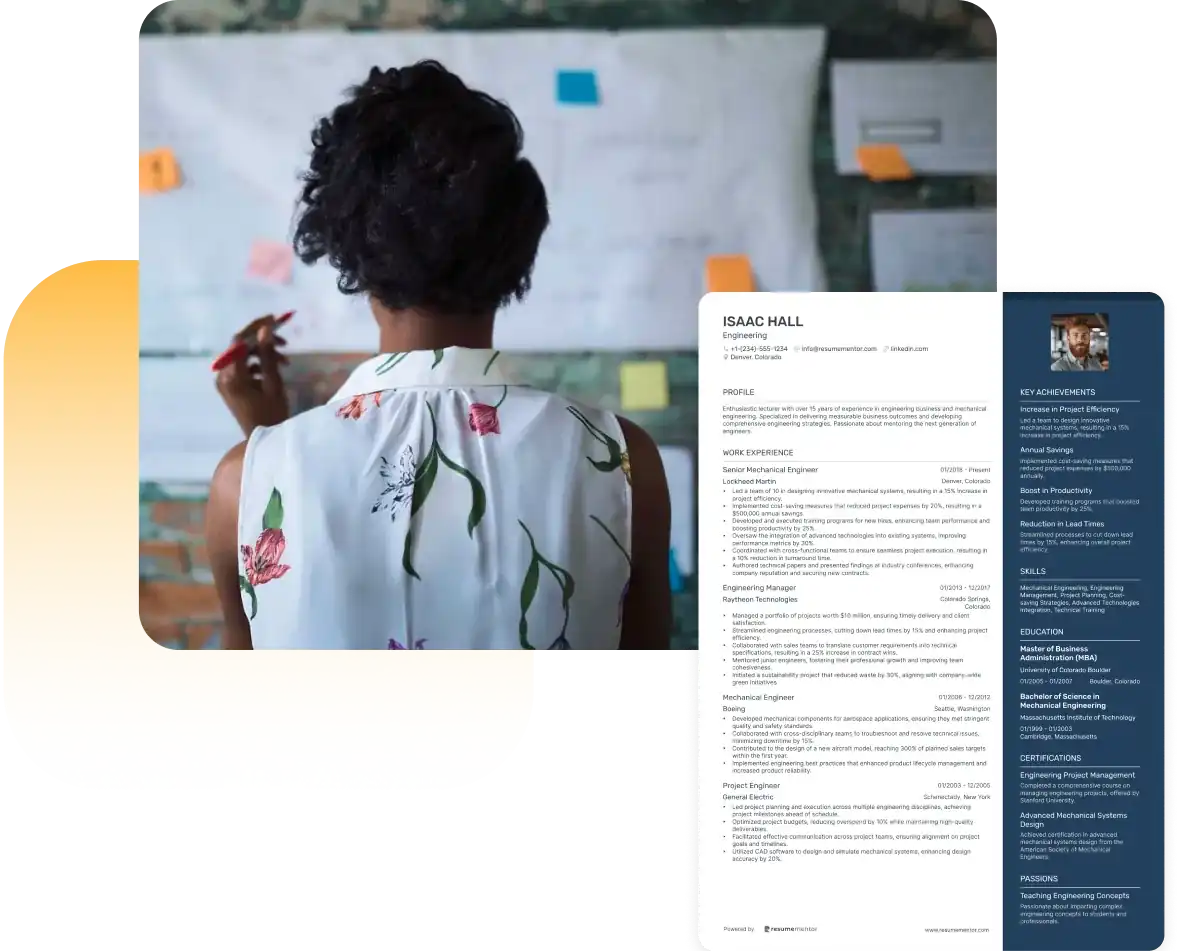
Continue Reading
Check more recommended readings to get the job of your dreams.
Resume
Resources
Tools
© 2025. All rights reserved.
Made with love by people who care.

